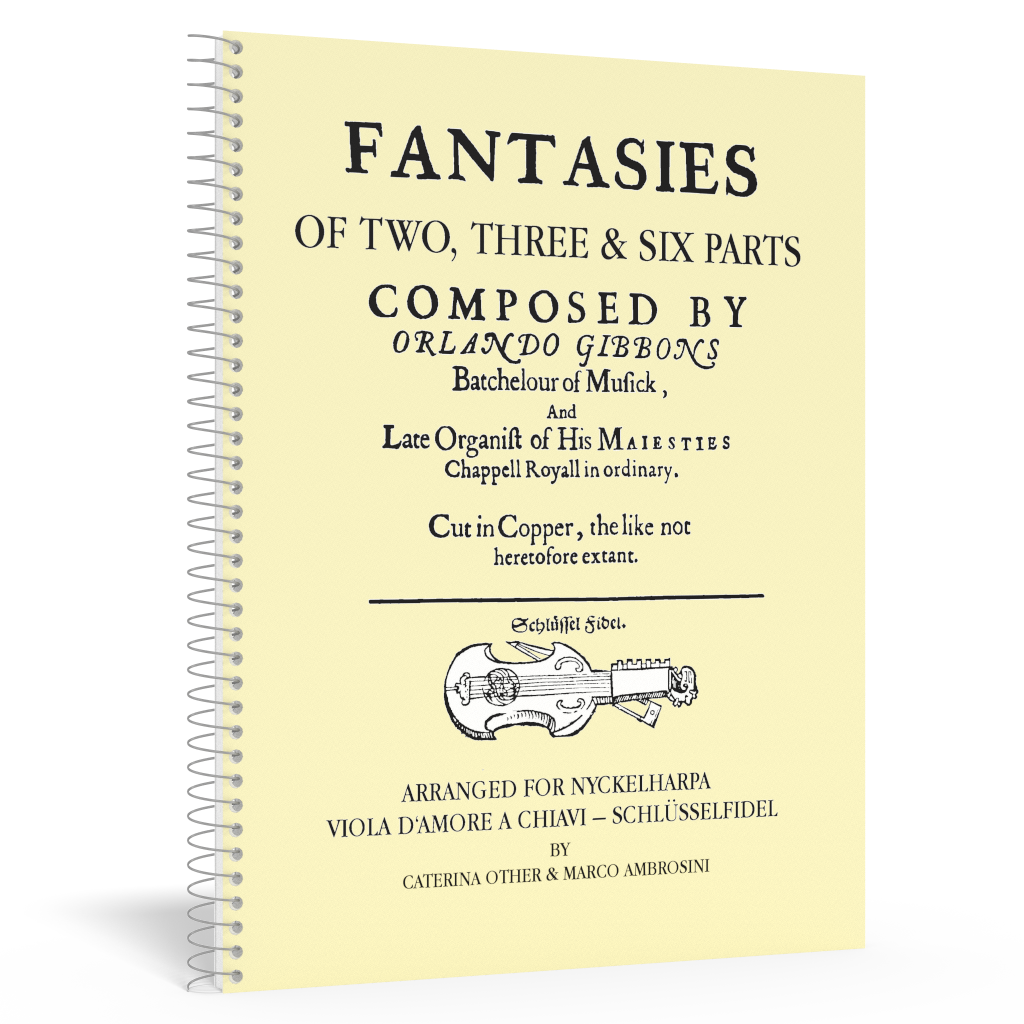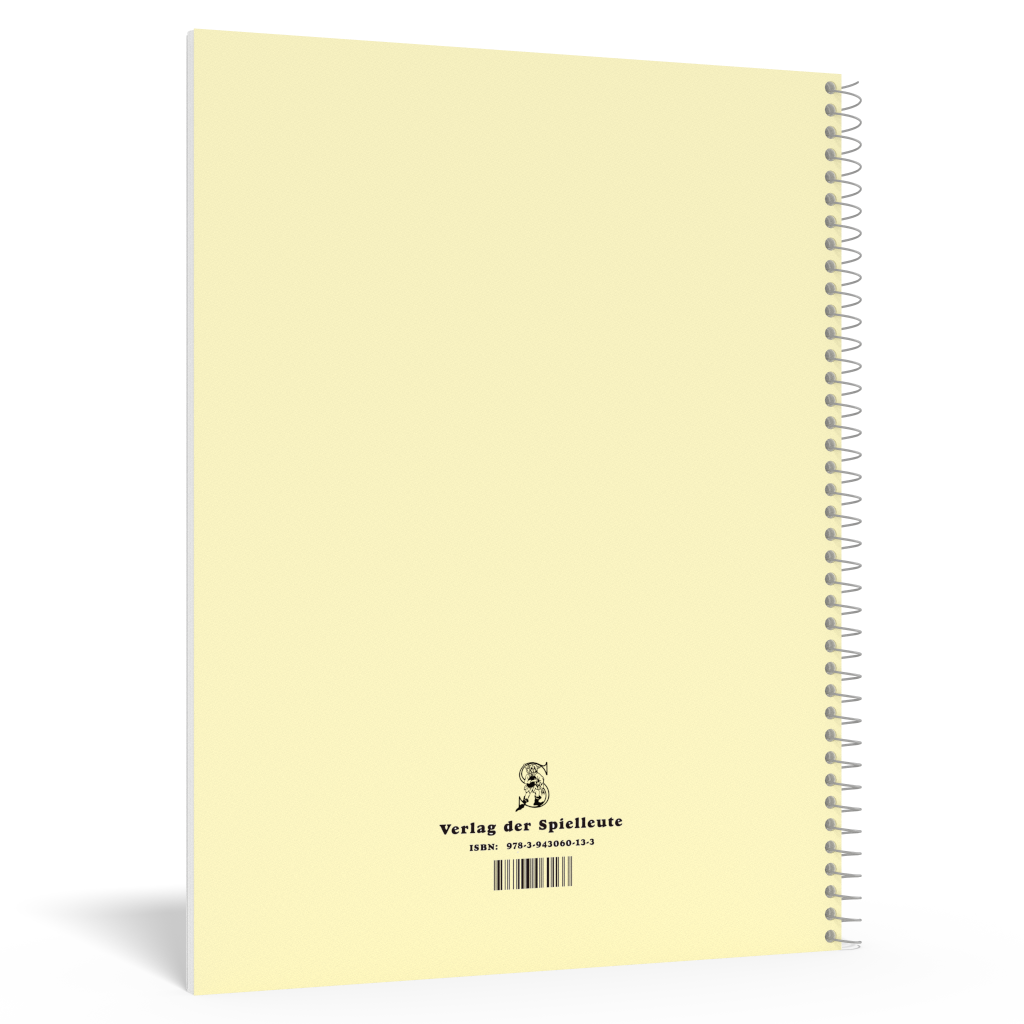Description
Immerse yourself in the world of the Renaissance with the masterfully arranged “Fantasies by Orlando Gibbons”. This exclusive collection, lovingly adapted for the nyckelharpa by Caterina Other and Marco Ambrosini, offers a unique musical journey through the fantasies in two, three and six parts by the famous composer of the Tudor and early Jacobean period.
Orlando Gibbons: a musical genius of the Renaissance
Orlando Gibbons, born in 1583 and baptized on Christmas Day, was an outstanding virginalist and organist of his time. As a member of the Chapel Royal and organist at Westminster Abbey, Gibbons left behind an impressive musical legacy that still resonates today. His works, including famous fantasias for viols, madrigals and hymns, testify to his extraordinary talent and versatility as a composer.
The nyckelharpa: an instrument full of history
The nyckelharpa, also known as the keyed fiddle or viola d’amore a chiavi, is a traditional Swedish string instrument with a rich history. With its unique timbre and ability to produce complex polyphonic textures, it is ideally suited for the performance of the “Fantasies by Orlando Gibbons”.
Why Gibbons’ music on the nyckelharpa?
In his work “Syntagma Musicum, Tomus Secundus”, Michael Praetorius described an English instrument with sympathetic strings, which increases the sweetness of the harmony through its resonating strings. This principle is continued in the modern nyckelharpa and brings Gibbons’ polyphonic fantasies and dance forms to life in an exciting way.
“Fantasies by Orlando Gibbons” is specially arranged for the nyckelharpa
Caterina Other and Marco Ambrosini have carefully arranged Gibbons’ fantasies for the 4-row nyckelharpa. This edition takes into account both traditional and modern tunings and instrument variations and is designed to fully exploit the possibilities of this unique instrument. With different clefs adapted to the specific needs of the nyckelharpa, the collection “Fantasies by Orlando Gibbons” enables an authentic and expressive performance.
Sharing a musical heritage
After years of performance practice, Other and Ambrosini have decided to share their knowledge and love of this music. This publication serves not only as a tribute to Orlando Gibbons, but also as a bridge between historical music practice and contemporary musicians who have dedicated themselves to the nyckelharpa.
Who is this collection for?
Whether you are an experienced nyckelharpa player looking to expand your repertoire or an early music lover seeking new soundscapes, “Fantasies by Orlando Gibbons” offers an unparalleled musical experience. Immerse yourself in the complexity and beauty of Gibbons’ work, presented on an instrument that is capable of capturing the depth and variety of this music like no other.
Foreword
Orlando Gibbons (baptized December 25, 1583 – June 5, 1625) was a virginalist and organist of the late Tudor and early Jacobean periods.
His life
Gibbons was born in 1583 (probably in December) and baptized on Christmas Day in Oxford, where his father William Gibbons worked as a waiter. Between 1596 and 1598 he sang in the choir of King’s College, Cambridge, where his brother Edward Gibbons (1568-1650), the eldest of William Gibbons’ four sons, conducted the choir. The second brother Ellis Gibbons (1573-1603) was also a promising composer, but died young. Orlando began studying at the university in 1598 and obtained a Bachelor of Music in 1606. In the same year he married Elizabeth Patten, daughter of a yeoman of the vestry, and they had seven children (Gibbons himself was the seventh of ten children).
King James I appointed him a gentleman of the Chapel Royal, where he worked as organist from around 1615 until his death. In 1623 he became principal organist of the Chapel Royal, with Thomas Tomkins as junior organist. He also worked as organist in the Privy Chamber of Prince Charles’s court (later King Charles I) and also in Westminster Abbey.
He died of a stroke in Canterbury at the age of 41 and was buried in Canterbury Cathedral. His death came as a shock to his peers and led to a post-mortem, although the cause of death attracted less attention than the haste with which he was buried and the fact that his body was not returned to London. His wife, Elizabeth, died just over a year later in her mid-30s, leaving Orlando’s eldest brother, Edward, to look after the orphaned siblings. Of these children, only the eldest son, Christopher Gibbons, was to become a musician.
His work
Gibbons, one of the most versatile English composers of his time, wrote a large number of works for keyboard instruments, around thirty fantasias for viols, a series of madrigals (the best known being ‘The Silver Swan’) and many popular verse anthems, all for English texts. Perhaps his best-known verse anthem is “This Is the Record of John”, which sets an Advent text for solo countertenor or tenor, alternating with full choir.
He also produced two major settings of Evensong, the Short Service and the Second Service, an extended composition combining verse and whole sections. Gibbons’ full anthems include the expressive ‘O Lord, in thy wrath’ and the Ascension hymn ‘O clap thy hands together’ for eight voices. He contributed six pieces to the first printed collection of keyboard music in England, Parthenia (to which he was by far the youngest of the three contributors), which was published around 1611. Gibbons’ surviving keyboard edition comprises about 45 pieces.
Polyphonic fantasy and dance forms are the best represented genres. Gibbons’ writing features a command for three- and four-part counterpoint. Most fantasias are complex, multi-part pieces that treat several themes imitatively. Gibbons’ approach to melody, both in his fantasies and in his dances, is characterized by a comprehensive development of simple musical ideas, such as in Pavane in D minor and ‘Lord Salisbury’s Pavan and Galliard’.
Why should the works of Orlando Gibbons be performed on the nyckelharpa?
In his book “Syntagma Musicum, Tomus Secundus”, Michael Praetorius wrote about an English instrument with sympathetic strings, the viola bastarda:
“Now something else strange has been discovered in England / that underneath the right common six sabres / there are still eight other stems and twisted brass sabres / on a brass bridge (like those used on the Pandorren) / which must be tuned in with the tops equally and quite purely. If now the uppermost of these strings is stirred with the finger or bow / then the lowest brass or steel strings resonate per consensus at the same time with trembling and tremolo, also / that the sweetness of the harmony is thereby, as it were, increased and extended.”
In recent years we have noticed a great interest in early music performances by nyckelharpa players! Our beloved instrument, not only as a more or less correct historical reconstruction, e.g. the so-called “Siena keyed vielle” or the “Moraharpa”, but also in its modern 4-row “continental” version, and its sound fits perfectly with music from the late Middle Ages to the Baroque.
Gibbons’ consort works have an exciting sound when played by two or more Nyckelharpor.
Some time ago, we started arranging this music for our students. We have spent a long time rehearsing and performing the fantasies, and now we have decided to spread the word and share our work in the form of this publication.
This edition of the Fantasias is specially designed for 4-row nyckelharpa, tuned in fifths. It should be noted that in almost all cases the upper voices are also suitable for 3-row instruments in the traditional and fifth tuning.
One problem that arises when arranging music for different instruments of the nyckelharpa family is the clefs used in the scores. In this case, it is a relatively new debate that has gone largely unnoticed in the Scandinavian milieu due to the greater prevalence of four-key row instruments on the continent.
The Swedish “traditional” instrument with its tuning, the three rows of keys and the use of the fourth string as a drone, requires no notes below the third empty string (G). For this reason, Swedish repertoire is normally notated in treble clef.
The case of the four-row nyckelharpa is clearly different. How do you write down the notes that are possible with the keys on the fourth string? In this case, we have decided to use three different notations: Treble clef (G clef), treble clef one octave lower (G clef) and bass clef (F clef).
Have fun!
Caterina Other & Marco Ambrosini
September 2017
Author:inside
Marco Ambrosini
Marco Ambrosini, born in 1964 in Forlì, Italy, is an outstanding musician, composer and arranger who began his musical journey in the world of classical music. He studied violin and composition and played in various orchestras and ensembles before his career took a fascinating turn.
His passion led him to the nyckelharpa, an almost forgotten but fascinating keyed fiddle. This instrument, which is a kind of violin with keys, inspired Marco, and he became one of the first to use the nyckelharpa outside Scandinavia, not only in Swedish folk music, but also in early and contemporary music.
Ambrosini is known for its artistic diversity. He has worked with renowned ensembles such as L’Arpeggiata, Oni Wytars and Supersonus and has conquered stages around the world. His talent also extends to jazz, where he has played with artists such as Michael Riessler and Jean-Louis Matinier.
With over 160 CDs recorded and released by prestigious labels such as Sony Classical, Deutsche Harmonia Mundi and ECM, Marco Ambrosini has firmly established his influence in the music world.
Marco also shares his passion and knowledge by teaching at various universities in Europe. He has also launched educational initiatives such as the European Nyckelharpa Training Course and is the artistic director of the Summer Master Classes for Early Music.
Marco Ambrosini is a world-class musician and a master of his craft. His music inspires and enriches the world of traditional music, and his influence extends across borders and ages.
Caterina Other
Caterina Other is an exceptional artist who has been immersed in the world of music since she was a child. She received her basic musical training on the violin, but her passion led her into the fascinating world of the Swedish nyckelharpa. Training at the Fürsteneck Castle Academy enabled her to discover the secrets of this unique instrument.
As a graduate of the European Nyckelharpa Advanced Training, Caterina now shares her knowledge and skills by giving courses and lessons for the nyckelharpa. Her passion for music extends to early music projects such as “bach transparent” as well as folk music with bands such as “Strömkarlen” and “Fröken Schultze”.
What sets Caterina apart is her deep connection to her own musical tradition and the way in which she lives it out in all its diversity. The nyckelharpa, a violin with 16 strings, has a very special meaning in her hands. It changes the pitch of the melody strings at the touch of a button, and the twelve additional resonance strings give its playing an unmistakable sound.
Caterina grew up in a musical family, but she made a conscious decision to follow her own musical path. After a successful career as a dressmaker in the Semper Opera and at medieval markets, a stroke of fate led her to devote herself entirely to music over ten years ago. The nyckelharpa became her new path, and she began a three-year training course that deepened her passion for this fascinating instrument.
Their music is a powerful crossover between old music and modern chanson. Caterina is a member of the Nyckelharpa Quartet and is constantly expanding her creative horizons. She is not only an outstanding musician, but also an inspiring teacher and has even introduced pupils to the art of the nyckelharpa in Dresden.
Caterina lives in Quohren near Dresden and is one of the few artists who are helping the nyckelharpa to flourish in Germany. Her music is characterized by melancholy, mysticism and mystery, and she is able to touch the soul of her listeners.





